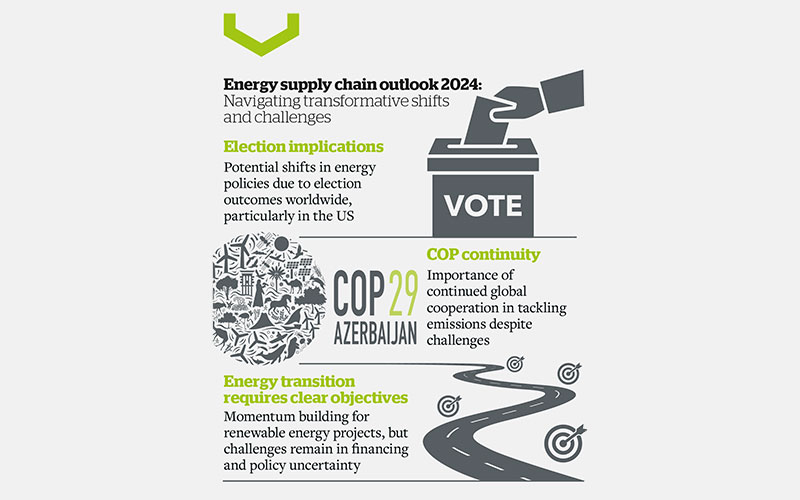Stranger times
As the energy sector braces for the challenges and opportunities of 2024, caution and uncertainty pervade the outlook. From impending elections shaping policy shifts to COP momentum and supply chain tensions, the landscape remains unpredictable, Sara Verbruggen finds out.

While 2023 was a positive year for many in the energy supply chain, global events and sector challenges – from labour shortages to demand uncertainty – mean 2024 will be daunting, but by no means dull.
Election outcomes
With many countries going to the polls this year, changes to energy policies could impact certain sectors. It is not hard to imagine what Donald Trump could do to America’s Inflation Reduction Act (IRA) should he take power in November.
The Federal licensing administrator Bureau of Ocean Energy Management (BOEM) has efficiently processed several offshore wind projects during Joe Biden’s tenure. Whether the pace will continue under a Republican government remains to be seen. Compared with four years ago, several US states – blue and red – have introduced policies to support offshore wind, with some projects now construction-ready, helping to offset any grinding of the Bureau’s gears in relation to renewables.
In countries with pending elections, it may be prudent to wait. “As an owner, you may decide to put on hold a major investment in a new vessel or port upgrade until you fully understand the policies of the new government,” says International Marine Contractors Association (IMCA) Chief Executive Iain Grainger.
COP momentum
With the UAE – a leading oil exporter – hosting last year, COP28 was in danger of looking like a cop-out on keeping emissions on the 1.5°C path. Yet it is the only platform capable of bringing together governments and energy industries (many state-owned) from across the world. “But unless there is political will to maintain those discussions and targets going forward, they will lapse,” says EIC Head of External Affairs Rebecca Groundwater. “The energy sector is global, the supply chain moves, and we can all help deliver for each other – but only if we can have a joined-up conversation.”
In February, during an event organised by the International Energy Agency at its Paris headquarters, COP28 President Sultan Al Jaber urged all parties that signed the UAE Consensus to enhance their Nationally Determined Contributions ahead of the next cycle in 2025, and said he would “continue to push for more” from the oil and gas industry to expand on the goal of 40% of global oil production committing to zero-methane emissions by 2030.
Supply chain tensions
The wider supply chain’s cross-sector ability is “made more challenging to fully leverage” due to lack of a pipeline of projects and visibility of projects on a sector-by-sector basis in the near-term, says Neil Golding, EIC’s Director of Market Intelligence.
This is particularly acute in offshore wind. After stability and growth, the sector seems markedly capricious. With leading developer Ørsted rolling back on its 2030 target of 50GW, companies that might have otherwise diversified into the sector will be putting investment decisions on hold. “All of this will-they-won’t-they, in terms of projects proceeding, is very unhelpful for the supply chain,” says Golding.
Smulders, a steel construction firm that diversified into offshore wind a few years ago, is on a good footing. “We secured our supply chain and have capacity for 4.5GW annually but actually hope to secure 6GW during 2024, which will see us through 2025,” says Eric Finé, Business Development Manager. “Then orderbooks are already starting to fill from 2026 onwards.”
In offshore energy, the volume of work is out there and the supply chain is better equipped to choose projects, where and whom to work for, according to Grainger. To assist contractors, IMCA published a set of contracting principles and a standard contract, free to use, as a starting point to share risk and reward more fairly between developers and contractors. IMCA is focused on avoiding mistakes of the past when offshore oil and gas companies moved into offshore wind.
“The offshore wind supply chain has reduced in the past two to three years,” says Grainger. “The growth in oil and gas, due to a heathy oil price, has seen some contractors return there, where clients tend to work more collaboratively and fairly with their supply chain.”
The energy sector is global, the supply chain moves, and we can all help deliver for each other – but only if we can have a joined-up conversation
Rebecca Groundwater, Head of External Affairs, EIC
Workforce issues
Labour shortages are also compounding some of offshore wind’s woes, notably in the UK where anti-immigration policy is delaying construction.
Grainger says: “The UK offshore oil, gas and wind industries rely on big international vessels for construction and then they leave to go to another project, making it neither safe nor economic to change the crew out for what amounts to a few months. IMCA, along with Renewable UK, Scottish Renewables, OEUK, NOF, Global Underwater Hub, and the UK Chamber of Shipping have informed the UK government of the impact that the UK Offshore Wind Workers Visa issue is having in terms of realising the UK’s net-zero ambitions and on the onshore UK jobs that supports these international vessels.”
Grainger says IMCA has had success in educating US lawmakers on the American Offshore Worker Fairness Act’s shortcomings. “There aren’t sufficient numbers of US mariners and trained personnel to man the construction vessels required for offshore wind farms, so we, along with US trade associations, have been informing US lawmakers about how any new Act would delay or impede these projects.”

Energy transition needs targets and more
With countries including India and Indonesia announcing targets for hydrogen and carbon, capture and storage, respectively, momentum is building – but the real action is happening in markets incentivising investments. US projects in hydrogen, biofuels and sustainable aviation fuels will reach a final investment decision (FID) in the next year or two. The IRA has been a “game changer” across cleantech, though its trajectory post-election remains uncertain, cautions Golding.
In the UK, carbon, capture and storage agreements will be reached at end of 2024. “But the UK needs to move faster with green hydrogen and the second allocation round,” says Golding. “We’ve seen the target of 1GW in production by 2025 turn into in production or construction by then.”
Policy uncertainty and lack of financing can delay projects. “Even markets that were anticipated to quickly establish, such as green hydrogen in Australia, have question marks over commercial viability,” says Golding. “First mover projects need to show the demand and prove the business case.” While there have been several mega-project announcements, such as the Western Green Energy Hub, FID is still some years away. That project has an Memorandum of Understanding with South Korean utility KEPCO, which paves the way for it to meet both domestic demand as well as demand for export to South Korea.

Inflation impact
The value of projects reaching FID in upstream oil and gas was up in 2023, according to EIC data – but the volume has reduced, a sign that price inflation is not only impacting sectors such as offshore wind. “There are large projects in the Middle East that have gone back out to retender,” says Golding. “Projects are struggling to reach FID even with a relatively stable oil price.” Meanwhile, with the Hinkley Point C nuclear project seeing another increase in prices, there are questions about affordability along with energy security. “Politicians are concerned about what’s going to give the taxpayer the best value for money,” Golding adds.
Joining up the dots
The energy industry supply chain has the collective will, experience and ingenuity to deliver but can often be hindered by the silos around different sectors, sometimes unintentionally exacerbated by policy. Groundwater reports members struggling to access finance where lenders and governments are reluctant to provide funding to low and zero-carbon projects when companies involved also operate in oil and gas.
“You cannot shut down one energy sector and hope another picks up the pace when we have a lack of capacity or a shortage of skills,” she says. The industry could be better served with analysis of market data to indicate where the work is, analysis of policy and geopolitics to help global members navigate risk, and insight into where markets are heading for the bigger picture, she adds.
Image credit | Shutterstock | iStock






Follow us
Advertise
Free e-Newsletter